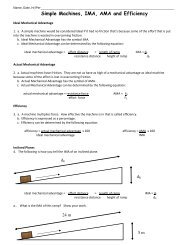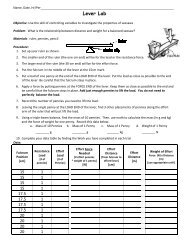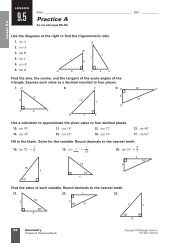Trends in the PT Graphing - Fulton County Schools
Trends in the PT Graphing - Fulton County Schools
Trends in the PT Graphing - Fulton County Schools
You also want an ePaper? Increase the reach of your titles
YUMPU automatically turns print PDFs into web optimized ePapers that Google loves.
<strong>Trends</strong> <strong>in</strong> <strong>the</strong> Periodic Table – Graph<strong>in</strong>g w/s<br />
Graph paper is 32 x 32<br />
1. Draw a l<strong>in</strong>e <strong>in</strong> <strong>the</strong> middle of a piece of graph paper, separat<strong>in</strong>g <strong>the</strong> page <strong>in</strong>to top and bottom [DONE FOR YOU].<br />
On <strong>the</strong> top, plot a graph of ionization energy (y-axis) vs. atomic number (x-axis). On <strong>the</strong> bottom plot a separate<br />
graph of atomic radius vs. atomic number. For each graph, connect successive dots with straight l<strong>in</strong>es. Also,<br />
ensure that identical atomic numbers are plotted on <strong>the</strong> same vertical position on <strong>the</strong> sheet (i.e. atomic number<br />
1 <strong>in</strong> <strong>the</strong> top graph should be on <strong>the</strong> same l<strong>in</strong>e as atomic number 1 <strong>in</strong> <strong>the</strong> bottom graph – your X axis is <strong>the</strong><br />
same).<br />
2. Exam<strong>in</strong>e your graph of ionization energy (IE) vs. atomic number.<br />
a. Which elements are found at <strong>the</strong> ma<strong>in</strong> peaks on your graph (<strong>the</strong>re should be 3)? What do <strong>the</strong>se<br />
elements have <strong>in</strong> common?<br />
b. Which elements are found at <strong>the</strong> ma<strong>in</strong> valleys on your graph (<strong>the</strong>re should be 3)? What do <strong>the</strong>se<br />
elements have <strong>in</strong> common?<br />
3. Exam<strong>in</strong>e your graph of atomic radius verses atomic number.<br />
a. Which elements are found at <strong>the</strong> peaks on your graph? What do <strong>the</strong>se elements have <strong>in</strong> common?<br />
b. Which elements are found at <strong>the</strong> valleys on your graph? What do <strong>the</strong>se elements have <strong>in</strong> common?<br />
28<br />
4. How are atomic radii and ionization energy related (i.e. as atomic radius <strong>in</strong>creases, what happens to <strong>the</strong><br />
ionization energy)?
5. Generally, as you go from left to right across a period on <strong>the</strong> periodic table, what happens to…<br />
a. atomic radius? b. ionization energy?<br />
6. Generally, as you go down a group <strong>in</strong> <strong>the</strong> periodic table, what happens to atomic radius and IE?<br />
7. When Na forms an ion it loses its outer electron to become Na+. Draw Bohr diagrams for Na and Na+.<br />
a. What element does Na+ resemble (with respect to its electron arrangement)?<br />
b. In general, which group’s electron configuration do <strong>the</strong> alkali metals resemble when <strong>the</strong>y form ions<br />
(i.e. lose an outer electron)?<br />
8. Why does radius <strong>in</strong>crease as you go down a group (h<strong>in</strong>t: th<strong>in</strong>k of Bohr diagrams)?<br />
9. Why would an <strong>in</strong>crease <strong>in</strong> radius make it easier to lose an outer electron (i.e. give a lower ionization energy)?<br />
10. What happens to <strong>the</strong> number of protons <strong>in</strong> <strong>the</strong> nucleus as you go across a period? Use this to expla<strong>in</strong> <strong>the</strong><br />
trends <strong>in</strong> atomic radius and ionization energy across a period.<br />
11. There is one group that is usually ignored because it does not follow <strong>the</strong> trends <strong>in</strong> <strong>the</strong> periodic table. Which<br />
group is usually ignored?<br />
12. Def<strong>in</strong>e electron aff<strong>in</strong>ity. In which corner of <strong>the</strong> periodic table is it highest? Expla<strong>in</strong> why this is so.<br />
13. Def<strong>in</strong>e Electronegativity. Where on <strong>the</strong> periodic table is it highest? Expla<strong>in</strong> why this is <strong>the</strong> case.<br />
Periodic Table Assignment w/s<br />
[crossword follows on next page]<br />
ACROSS<br />
1. Syn<strong>the</strong>tic elements with atomic numbers greater than 93<br />
5. This law states that <strong>the</strong> properties of elements repeat as a function of <strong>the</strong>ir atomic number<br />
7. Silicon is <strong>in</strong> this period<br />
8. Elements were orig<strong>in</strong>ally placed <strong>in</strong> order of atomic __, now <strong>the</strong>y are <strong>in</strong> order of atomic __.<br />
9. The group that consists of very nonreactive gases<br />
10. Number of elements known <strong>in</strong> 1800<br />
13. Element 101 was named <strong>in</strong> his honor<br />
17. The periodic table is normally drawn with 18 columns. A more accurate representation has ___ columns<br />
19. Most nonmetals are <strong>in</strong> this state<br />
20. Nonmetal that is a liquid at SATP<br />
21. The general name given to a column <strong>in</strong> <strong>the</strong> periodic table<br />
22. Accord<strong>in</strong>g to figure 6, when alum<strong>in</strong>um comb<strong>in</strong>es with oxygen, three oxygen atoms comb<strong>in</strong>e with this many<br />
alum<strong>in</strong>um atoms 29








![BDOL [Whale Book] Principles of Ecology - Fulton County Schools](https://img.yumpu.com/50102234/1/190x245/bdol-whale-book-principles-of-ecology-fulton-county-schools.jpg?quality=85)








